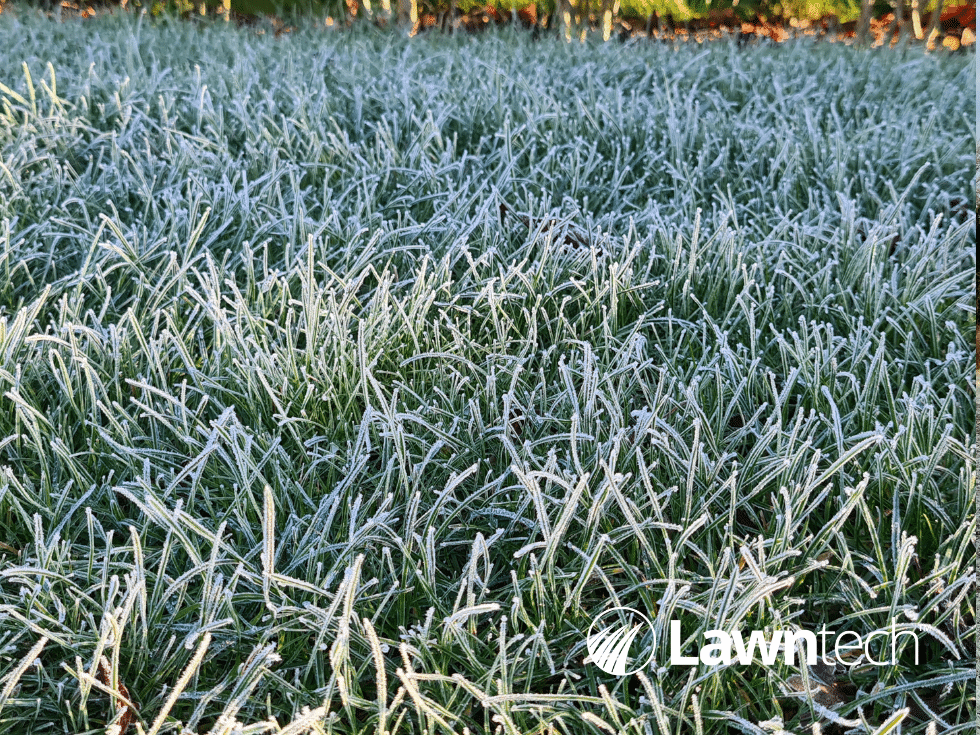There is something magical in the wintry mornings waking up to frosty white lawns, sparking like jewels in the low light of dawn.
It’s something quite poetic, postcard perfect you could say. But we hold our thoughts there as we wonder… Can the frost be damaging to our lawn?
Frost on your lawn itself, does not cause damage to your grass and there are certainly some benefits to a frosty lawn. The real damage occurs when we cannot resist the temptation to walk across our Winter Wonderland in the crisp, clear morning. As tempting as this can be, it is important you don’t walk on your grass during frost.
At Lawntech, we have put together some useful information for those frosty mornings ahead.
Should I be concerned for frost on my lawn?
There is no need for concern to see frost itself on your lawn as there are positive attributes that the frost brings with it. During frost, the cells within the grass plants become frozen and as they adapt to this, the roots are encouraged to strengthen. This process helps to toughen up the grass plants leading to a more resilient, stronger root system.
Why is it important that I don’t walk on my lawn when it’s frosty?
Walking across your frosty lawn will cause damage to your grass. It is important to remember the frozen grass leaves are brittle, and any traffic across these weakened leaves will cause the grass leaves to fracture causing damage to the lawn that takes a long time to repair. So, to protect the grass leaves from rupture (unless there’s a reason you must) please do not walk across your lawn whilst it’s frosty.

Walking across your frosty lawn will cause damage. Unless you must, it is important to avoid doing so.
Can I mow a frosty lawn?
Never mow a frosty lawn. For the same reasons we advise you how important it is not to walk on your frosty lawn to avoid damage, mowing a frosty lawn will cause even more destruction. Walking on the grass and then cutting the grass blades with your mower whilst they are frozen will only fracture and break the grass blades. Although your lawn will eventually recover from this damage this will take a long time to do so, so your lawn is not likely to have repaired itself from the damage until the following spring.
Can you apply treatments to a frosty lawn?
This is another important no-no! Treatments we apply at Lawntech such as our fertiliser and weed killer are dependent on ground temperatures. They should not be applied until the spring once the ground temperatures are warmer. Our lawn treatment year begins in March, with an application of Early Spring Fertiliser from our Annual Lawn Care Programme.

Mowing your lawn when the grass blades are frozen will fracture the glass blades and cause damage to your lawn.
So, what can I do for my lawn when the frost bites?
To round it up; no walking on the lawn, no mowing and no lawn treatments will protect your lawn from damage during frost. Once ground temperatures have risen, check your lawn for Frost Heave.
Frost Heave occurs when the moisture within the soil freezes causing the soil to swell upward as it is pushed by this frozen water. After lengthy periods of sub-zero temperatures, this can leave humps and cracks in the soil due to the frozen water causing it to burst out of the ground.
As ground temperatures continue to rise again, the impact of Frost Heave should settle back on its own, unless your lawn has suffered severe effects. A light rolling or lawn top dressing to smooth out the surface can help but this cannot be carried out until springtime when the temperatures are warmer.
If you find your lawn has suffered severe damage, a repair using fresh turf is a good solution – our sister company, The Lawn Store, offer a range of high quality turf available on their website www.thelawnstore.co.uk.
Alternatively, you can Contact Us for a free-no obligation survey if you find the frost has been more frightful than friendly to your lawn this winter.



